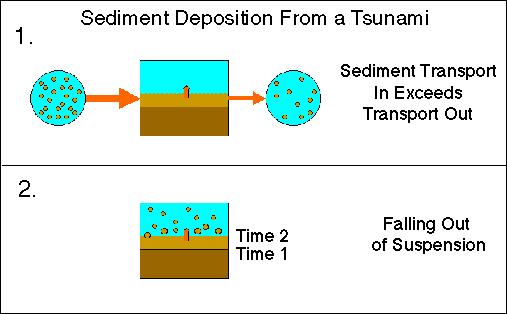Preliminary Analysis of Sedimentary Deposits
from the June 23, 2001 Peru Tsunami
[ Introduction | Team | Importance of Studying Tsunami Sediments | Survey and Methods | Damage | Run-up | Sedimentary Deposits | Preliminary Results | Future Research | Acknowledgments ]
The Importance of Studying Tsunami Sediments
Tsunamis often leave a layer of sediments that may be preserved in the geologic record. The geologic record may then be used to help assess tsunami hazard. In some cases, this record may be the only evidence that a region may be at risk from a tsunami. Where more than one tsunami deposit is preserved in a stratigraphic sequence, the record may help determine how often a tsunami is likely to occur. Tsunami sediments may also record important information about the wave that deposited them. By examining the thickness and grain size distribution of tsunami deposits, scientists may be able to deduce the wave height and flow velocity of the wave. Wave height and flow velocity are among the most important properties of a tsunami that determine how destructive the wave is. By studying sediments from recent tsunamis, we may be better able identify and interpret tsunami sediments in the geologic record.

Deposition of sediment by a tsunami is governed by two basic processes. In the first process, deposition occurs through gradients in transport (more sediment goes into an area than comes out). Deposition also occurs by sediment falling out of suspension. USGS scientists will use data from the Peruvian tsunami sedimentary deposits to determine which process is dominant. This will aid in the development of sediment transport models that may be used to determine the wave height and flow velocity of the tsunami.
